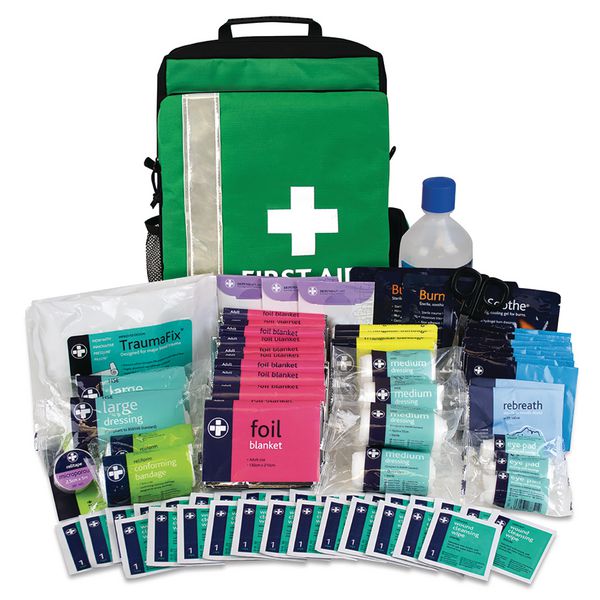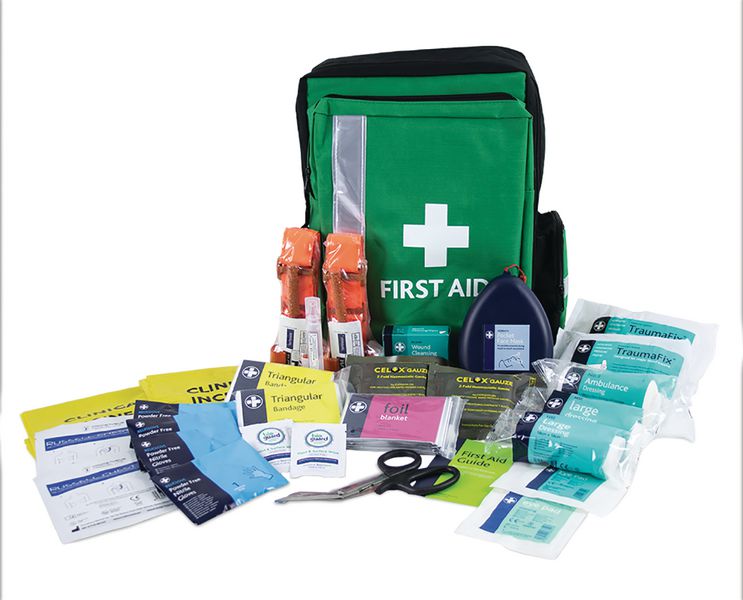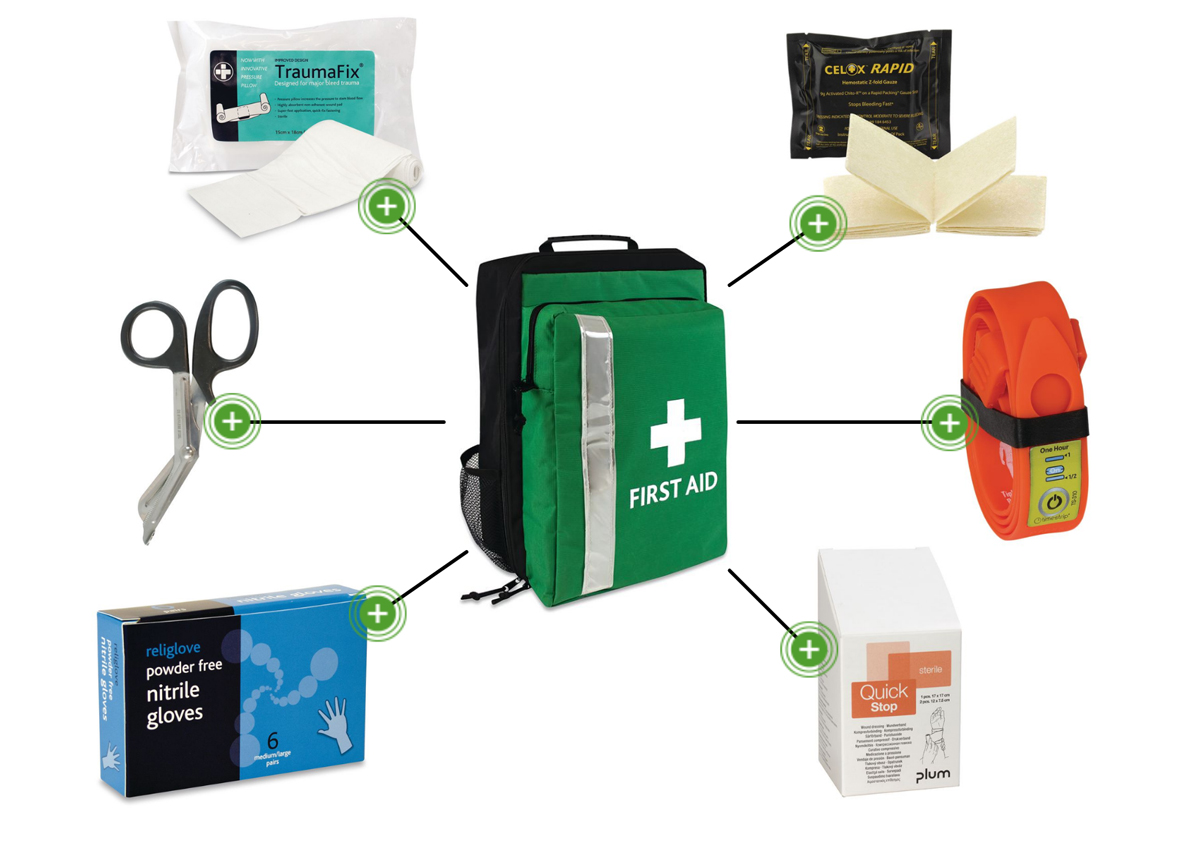-

Major Incident First Aid Kit
£225.43Supplied in: Single -

First Response Rucksack First Aid Kit
£76.32Supplied in: Single -

Bleeding Control Kit
£217.00Supplied in: Single kit -

Critical Injury Kit
£162.00Supplied in: Single kit -

Standard Trauma Kit
£251.00Supplied in: Single -

Public Access Bleeding Control Station
£1,994.00Supplied in: Single -

Security Trauma Kit
£329.00Supplied in: Single -

Forestry First Aid Kit
£67.45Supplied in: Single -

Industrial Trauma Kit
£270.00Supplied in: Single -

Acid Attack Kit
£65.65Supplied in: Single -

Agriculture Trauma Kit
£265.00Supplied in: Single -

Photoluminescent Burns First Aid Kit
£45.81Supplied in: Single kit
Trauma Kits
Need help?
 Are you ready to deal with multiple casualties at work?
UK Approved Life Saving Medical Trauma Kits - Fast Delivery!
Are you ready to deal with multiple casualties at work?
UK Approved Life Saving Medical Trauma Kits - Fast Delivery!
A trauma kit is designed to treat major injuries or control bleeding until professional medical attention can be received. With increased awareness around mass casualty incidents like terrorist attacks, keeping trauma relief equipment in public and outdoor spaces is becoming more and more important. When you have conducted your first aid risk assessment you may discover the need for more specialised equipment, such as items to stem serious bleeding and increase the chance of saving lives. A person can die from blood loss in under 5 minutes, so if there is a risk of this occurring, find out if you need bleeding control kits in the vicinity and ensure you are compliant with health and safety legislation.

Expert Information
Also discover:
First Aid SuppliesFirst Aid KitsCar First Aid KitsCatering First Aid KitsFirst Aid BagsWorkplace First Aid KitsSports First Aid KitsFirst Aid Kit RefillsTravel First Aid KitsSchool First Aid Kits
Trauma Kits - What you need to know
What should be in a trauma kit?
A standard trauma kit typically contains items to stem the flow of major bleeds in various parts of the body. Trauma kit essentials might include;
- Tourniquets - allow the first responder to treat major blood loss or severed limbs at arm/legs.
- Chest Seals - for the treatment of open chest wounds
- Trauma Dressings - for the control or moderate to severe bleeding
- Compression Dressings - such as the Israeli dressing
- Dressings, impregnated with haemostatic agents - such as Haemostatic Gauze (which cause the blood to form a gel)
- Gloves - for protection against blood cross-contamination
- Shears - for cutting through the injured person’s clothing
How is a trauma kit different from a first aid kit?
Trauma kits, also referred to as tactical first aid kits, tactical medical kits or advanced first aid kits, are designed to treat major, usually life-threatening, injuries. A trauma toolkit does not include the ‘everyday’ items you might find in a typical first aid kit, such as plasters.
Whilst a first aid kit might contain some trauma emergency kit items - such as a First Aid Kit designed for motoring including trauma dressing's it is important to note that a trauma response kit is designed specifically to treat significant (and potentially multiple) casualties, injured in a major incident. Often the aim of a trauma kit is designed to keep the injured person(s) alive until emergency medical professionals can take over.
Typically an ambulance is able to respond to a call in around 8 minutes, in the UK, however it is possible for a case of severe blood loss to become life-threatening in as little as 3-5 minutes; so having the right trauma equipment to hand can be a matter of life and death.
It remains important to have a regular first aid kit available for everyday, non life-threatening, injuries - trauma kits are not a replacement, but are a specialised addition to first aid protection.
| Typical Contents | First Aid Kit | Trauma Kit |
|---|---|---|
| Chest Seal | ||
| Compression Dressing | ||
| Eye Pad Dressing | ||
| First Aid Guide Leaflet | ||
| Gloves | ||
| Haemostatic Dressing | ||
| Plasters | ||
| Tourniquet | ||
| Trauma Dressing | ||
| Triangular Bandage | ||
| Wound Dressing |
What are the different types of trauma kits?
There are many different trauma kits and each will contain some specific items in the bag, backpack or pouch.
For example our Critical Injury Kit provides life-saving equipment to stem the flow of catastrophic blood loss. Designed to treat 1-3 people this kit includes a tourniquet, trauma and haemostatic dressings as well as a foil blanket.
With contents specially chosen to respond to major trauma at larger events (approx. 100 people); our Major Incident First Aid Kit contains a full complement of essentials. The full kit list includes specialised equipment such as tourniquets, burn gels, burn dressings, and trauma dressings alongside more conventional first aid items like waterproof plasters.
An increased awareness around mass casualty incidents, (like terrorist attacks) and rising knife-crime means its never been more important to have Bleeding Control Kits or Public Access Bleeding Control Stations available nearby, should the worse happen. Typically containing one or more tourniquets, chest seals, haemorrhage control dressings, as well as haemostatic gauze and control dressings.
Whether as a result of industrial accident or personal attack, injuries from chemical splashes can have devastating impact on an individual. Our Acid Attack Kit is supplied in a quick response rucksack and includes chemical resistant gloves, 20ml eye wash pods, HSE approved dressings, safety goggles and more to deliver a rapid first response to such traumatic injuries from exposure to both acid and alkali compounds.
For many injuries from burns are likely the most extreme risk in their day to day routine, which is why, particularly in workplaces, it is worthwhile keeping a Burns First Aid Kit on standby. Compliant to BS 8599-1 this kit includes bandages, dressings and gels designed to quickly soothe and help burn injuries heal.
It is fair to say some professions simply come with more risks than most, where trauma kits are concerned and Forestry/Agriculture is definitely one that falls into this category. Which is why our Forestry First Aid Kit and Agriculture Trauma Kit are both designed to keep life-saving equipment close by. While the Forestry First Aid Kit is designed to be mounted to a wall or suitable machinery, the Agriculture Trauma Kit is supplied in a backpack style bag, to quickly get supplies to the injured person(s).
| Product | BS Compliant | HSE Approved | No. of Users | Risk Type | Package Type |
|---|---|---|---|---|---|
| Acid Attack Kit | 10+ people | Eye Care, Burns | Rucksack | ||
| Agriculture Trauma Kit | 1-10 people | Burns, Eye Care, Severed Body Part, Cuts | Rucksack | ||
| Bleeding Control Kit | 1-4 people | Blood Exposure, Cuts | Pouch | ||
| Critical Injury Kit | 1-3 people | Haemorrhage, Cuts | Travel Bag | ||
| First Response Rucksack First Aid Kit | 20+ people | Resuscitation, Eye Care, Cuts, Burns, Knocks | Rucksack | ||
| Forestry First Aid Kit | 1-3 people | Haemorrhage. Severed Body Part, Cuts | Case | ||
| Industrial Trauma Kit | 1-10 people | Burns, Eye Care, Blood Exposure, Severed Body Part | Rucksack | ||
| Major Incident First Aid Kit | 100 people | Eye Care, Cuts, Muscle Injuries, Resuscitation | Bag | ||
| Photoluminescent Burns First Aid Kit | 1-4 people | Burns | Case | ||
| Public Access Bleeding Control Station | 1-4 people | Cuts, Blood Exposure | Case, Zip-lock Bag, Pouches | ||
| Security Trauma Kit | 10+ people | Eye Care, Blood Exposure, Cuts | Rucksack | ||
| Standard Trauma Kit | 1-4 people | Eye Care, Cuts, Haemorrhage | Rucksack |
What specialist training is required?
The HSE advises that where haemostatic dressings and tourniquets are provided in first aid kits that training should be provided to ensure they are able to be applied safely and effectively.
Training in the use of trauma kits is advised for specific industries such as forestry, construction, agriculture, events and hospitality, as well as any public events where there is a risk of a mass casualty incident.
Mass Casualty Incidents (MCI)
By definition a mass casualty event is any incident where the available emergency medical services are overwhelmed, in either resource of personnel, by the number of casualties requiring attention. Typically a mass casualty incident (MCI) is caused by acts of terrorism, mass-transportation accidents, as well as natural disasters.
In the UK, Police will not allow paramedics into the area of an ongoing MCI until it has been confirmed safe. With this in mind storing multiple trauma kits in the immediate vicinity will help ensure equipment is available for those already on the scene to take measures to respond and treat the injured.
Whilst MCIs are usually high profile incidents, the impact of more everyday events such as car crashes, knife crime and extreme weather events can be greatly reduced by having life-saving equipment suitably close.



